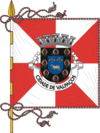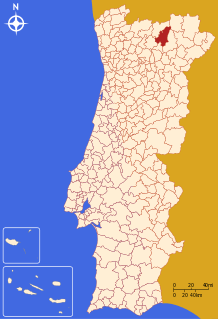Valpaços
Valpaços (Portuguese pronunciation: [ˌvalˈpasuʃ] (![]()
Valpaços | |
|---|---|
 Flag  Coat of arms | |
 | |
| Coordinates: 41°36′35″N 7°18′44″W | |
| Country | |
| Region | Norte |
| Intermunic. comm. | Alto Tâmega |
| District | Vila Real |
| Parishes | 25 (see text) |
| Government | |
| • President | Amílcar Almeida (PPD-PSD) |
| Area | |
| • Total | 548.74 km2 (211.87 sq mi) |
| Elevation | 515 m (1,690 ft) |
| Population (2011) | |
| • Total | 16,882 |
| • Density | 31/km2 (80/sq mi) |
| Time zone | UTC±00:00 (WET) |
| • Summer (DST) | UTC+01:00 (WEST) |
| Postal code | 5430 |
| Area code | 278 |
| Patron | Nossa Senhora da Saúde |
| Website | http://www.valpacos.pt |
History
The first documents that cite Valpaços date back to the 12th century. Its toponymy evolved from pre-national settlements, and started as a small enclave inhabited by nobles and signeurial family estates, attracted by the privileges given for settling so close to the Spanish border. The nascent Portuguese community was susceptible to attacks from Spain. The establishment of border settlements fixed the border.
Historically, Vale de Paço (and later Vale de Paços until the 19th century) was an area with roots in the Roman period of settlement, yet influenced by Germanic settlers before Portugal became a Kingdom.
The most important event in the regions history occurred in the 19th century. On 16 November 1846, during the Patuleia conflict, a movement that was apolitical turned bloody, resulting in the deaths of 200 people, before the battle proceeded into the lands of Murça.
Geography
Valpaços is located in the northern interior of Portugal in the Alto Trás-os-Montes region, and part of the district of Vila Real. It is confined in the north by the municipality of Chaves, to the east by Mirandela and Vinhais, to the south by Murça and Mirandela and in the west by Chaves and Vila Pouca de Aguiar.[3]
From north to south, the Transmontanan relief is exemplified by planar stretches of the Iberian Meseta, with altitudes between 700–800 metres above sea level, tending to have a regular profile north of the Douro River.[4][5]
Regional and national connections between the municipality and its neighbours are completed across several of its primary and secondary roadways: the 213 (Chaves–Valpaços-Mirandela-Vila Flor); the 103 (Viana do Castelo-Braga–Chaves-Bragança); the 206 (Vila do Conde–Valpaços–Bragança); and the 314 (Chaves–Carrazedo de Montenegro-Murça IP4).[6] The important link is the 206 to A24, which links Valpaços with Vila Real, Viseu and internationally to Spain (Espanha–Verin-A52 roadway), and the national A7 which permits a rapid connection with the coast (Guimarães, Braga and Porto).[6] The ancillary connection to the national 213 also permits a rapid connection to the IP4, which links Valpaços with Porto, Vila Real and Bragança.[6]
Administratively, the municipality is divided into 25 civil parishes (freguesias):[7]
- Água Revés e Crasto
- Algeriz
- Bouçoães
- Canaveses
- Carrazedo de Montenegro e Curros
- Ervões
- Fornos do Pinhal
- Friões
- Lebução, Fiães e Nozelos
- Padrela e Tazem
- Possacos
- Rio Torto
- Santa Maria de Emeres
- Santa Valha
- Santiago da Ribeira de Alhariz
- São João da Corveira
- São Pedro de Veiga de Lila
- Serapicos
- Sonim e Barreiros
- Tinhela e Alvarelhos
- Vales
- Valpaços e Sanfins
- Vassal
- Veiga de Lila
- Vilarandelo
See also
- Valpaços IPR
References
Notes
- Instituto Nacional de Estatística
- "Áreas das freguesias, concelhos, distritos e país". Archived from the original on 2018-11-05. Retrieved 2018-11-05.
- Câmara Municipal, ed. (19 May 2008). "Enquadramente Geográfico" (in Portuguese). Valpaços, Portugal: Câmara Municipal de Valpaços. Archived from the original on 23 May 2011. Retrieved 18 May 2011.
- Pierre Birot (1946)
- A. Brum Ferreira (1978)
- Câmara Municipal, ed. (19 May 2008). "Accessibilidades" (in Portuguese). Valpaços, Portugal: Câmara Municipal de Valpaços. Archived from the original on 23 May 2011. Retrieved 18 May 2011.
- Diário da República. "Law nr. 11-A/2013, pages 552 125-126" (pdf) (in Portuguese). Retrieved 4 August 2014.
References
- Câmara Municipal, ed. (2006). "Concelho: Cartografia" (in Portuguese). Valpaços, Portugal: Câmara Municipal de Valpaços. Archived from the original on 6 May 2011. Retrieved 18 May 2011.
- Birot, Pierre (1946), Contribution a l'Étude morphologique de la région de Guarda (in French), Lisbon, Portugal: Bull. Études Portugal, p. 47
- Ferreira, António de Brum (1978), "Planaltos e montanhas do Norte da Beira. Estudo de Geomorfologia", Memórias do Centre de Estudos Geográficas (in Portuguese), Lisbon, Portugal